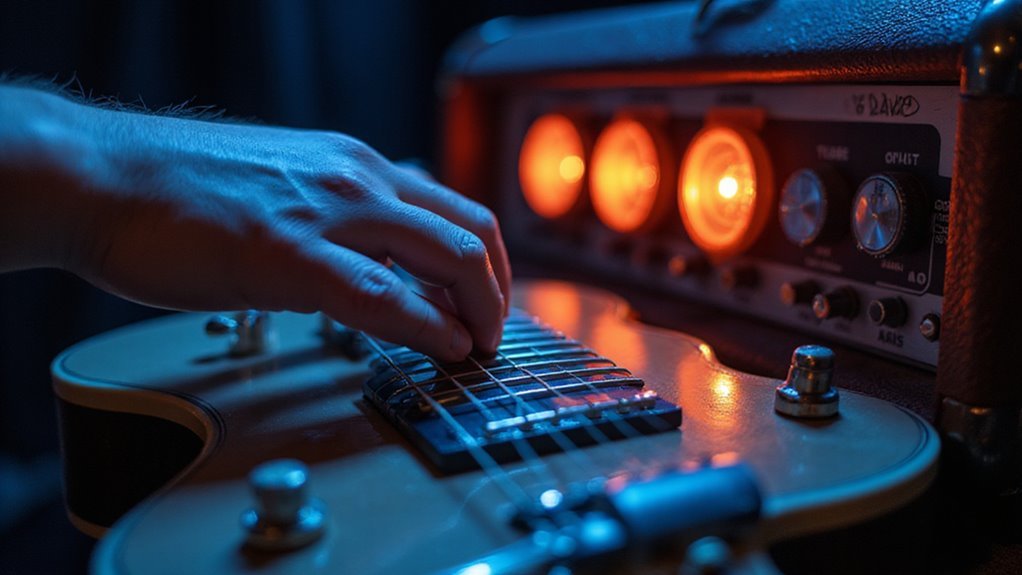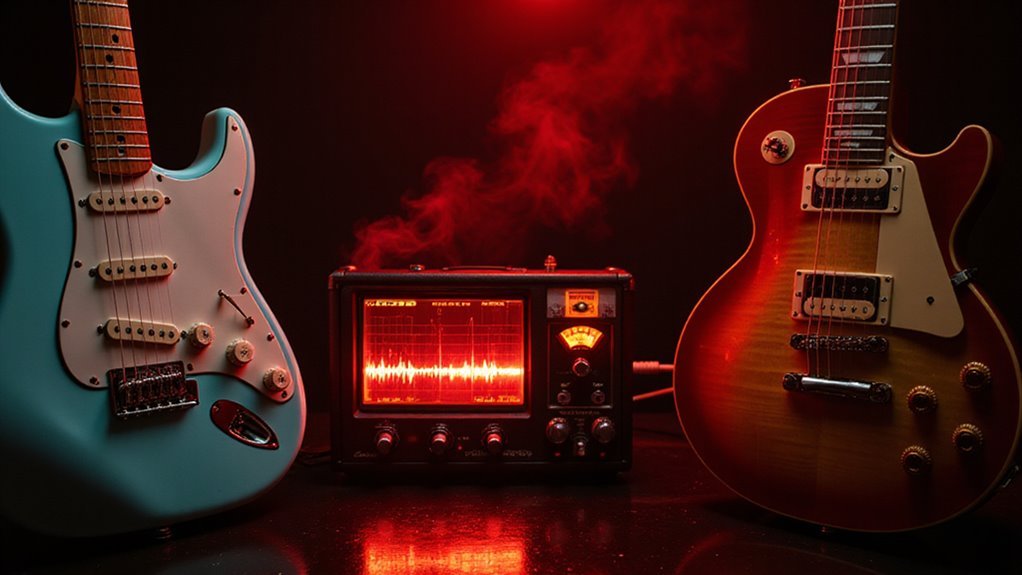The battle between distortion and overdrive pedals confuses many guitarists. They seem similar, yet produce distinctly different tones that can make or break a musical performance. Most players use them interchangeably at first, perhaps not fully understanding the sonic characteristics that separate them. The science behind each effect reveals why certain genres gravitate toward one or the other. The difference matters – especially when trying to nail those iconic guitar sounds that defined generations of music.
The Science Behind the Squeal: How Distortion and Overdrive Work

How exactly do these two iconic guitar effects transform a clean signal into the searing sounds that define rock music?
It’s all about wave clipping, really. When your guitar signal exceeds what a circuit can handle, magic happens.
Distortion aggressively clips the signal, creating those square-like waveforms that give us that thick, saturated sound many metal heads crave.
It’s perhaps a bit less forgiving of playing nuances.
Overdrive, on the other hand, offers a gentler approach. It softly clips the peaks, preserving more of your original tone while adding warmth that tube amps naturally create when pushed just right.
Gain Wars: Comparing Signal Strength and Intensity

When guitarists talk about gain, they’re really discussing the heart of what makes distortion and overdrive fundamentally different.
It’s a pivotal distinction that shapes your tonal identity within the guitar community.
The gain difference between these effects creates remarkably different experiences:
- Distortion typically delivers higher gain, resulting in intense saturation and aggressive character.
- Overdrive offers more subtle gain that responds to your playing dynamics.
- Higher gain distortion tends to compress your tone, sometimes masking nuances.
- Overdrive’s softer gain profile preserves more of your guitar’s natural voice and expression.
Perhaps the most telling difference is how each responds to your personal touch.
Tone Characteristics: Thick Aggression vs. Smooth Warmth

While distortion and overdrive both color your guitar’s signal, their tonal fingerprints couldn’t be more distinct from one another.
Distortion produces a thicker, more aggressive sound that fundamentally transforms your guitar’s voice into something grittier and more modern. It’s perhaps why so many players in heavier genres gravitate toward it.
Distortion rewrites your guitar’s DNA with grit and aggression—the secret language of modern heavy music.
Overdrive, on the other hand, offers a smoother, warmer enhancement that respects the original character of your instrument. Rather than completely altering your tone, it enriches what’s already there.
I think this is why it feels more natural to many guitarists who want their instrument’s voice to remain recognizable, just with a bit more muscle behind it.
Dynamic Response: Playing Expressiveness and Signal Saturation
The tonal character of an effect pedal tells only half the story; the way it responds to a guitarist’s touch reveals the other half.
When comparing distortion and overdrive, their dynamic responses create fundamentally different playing experiences.
Overdrive preserves your playing dynamics, while distortion tends to compress them. I think this is why many blues players prefer overdrive pedals.
- Expressive Range – Overdrive responds to pick attack intensity
- Signal Saturation – Distortion compresses more aggressively
- Playing Nuance – Subtle techniques often get lost in heavy distortion
- Volume Sensitivity – Rolling back guitar volume cleans up overdrive more naturally
Perhaps what makes overdrive special is how it breathes with your playing.
Genre Applications: From Blues Warmth to Metal Mayhem
Different genres naturally gravitate toward specific tonal characteristics, making the choice between distortion and overdrive essential for achieving authentic sounds.
Blues players often prefer the warm, responsive nature of overdrive pedals that complement their expressive bends and dynamic picking. Perhaps it’s this preservation of nuance that makes overdrive the go-to for country and classic rock guitarists as well.
Metal and hard rock, on the other hand, typically embrace distortion’s aggressive edge and compressed sustain. The genre almost demands that wall-of-sound approach, though some players might combine both effects—using overdrive to push an already distorted signal for solos that cut through the mix.
Pedal Talk: Controls, Settings, and Maximizing Your Sound
Understanding the controls on distortion and overdrive pedals might seem overwhelming at first, but mastering these knobs and switches reveals a world of tonal possibilities for guitarists at any level.
Most pedals share similar controls, though they affect your sound differently depending on whether you’re using distortion or overdrive.
When dialing in your perfect tone, remember these key adjustments:
- Gain/Drive – Controls the intensity of clipping (softer for overdrive, harsher for distortion)
- Tone/EQ – Shapes frequency response, vital for fitting your band’s mix
- Level/Volume – Balances your effected signal with bypass volume
- Presence/Contour – Adjusts mid-range character, perhaps the most overlooked yet important control
Frequently Asked Questions
Can You Use Distortion and Overdrive Effects Simultaneously?
Guitarists can stack distortion and overdrive effects together, creating layered tones with increased sustain. This combination allows for versatile sound sculpting while maintaining some dynamic responsiveness from the overdrive section.
How Do Vintage Versus Modern Pedals Influence These Effects?
Vintage pedals typically offer warmer, more organic distortion and overdrive tones, while modern pedals provide greater tonal options, enhanced clarity, and more refined gain staging capabilities for today’s musicians.
Do Different Guitar Pickups Affect Overdrive and Distortion Differently?
Different guitar pickups greatly impact these effects. High-output humbuckers saturate distortion more aggressively, while single-coils retain clarity with overdrive, enhancing their characteristic bite and dynamic responsiveness.
Will These Effects Sound Different Through Headphones Versus Amplifiers?
Like hearing a waterfall through a window versus standing beneath it, guitar effects sound different through headphones versus amplifiers. Headphones provide direct, intimate sound while amplifiers offer room interaction and physical presence that affects tonal perception.
How Do These Effects Interact With Digital Modeling Technology?
Digital modeling technology accurately replicates both distortion and overdrive characteristics, offering players countless virtual options without physical gear. Modern modelers capture subtle differences in clipping, harmonics, and dynamic responses effectively.
Conclusion
When the dust settles, the choice between distortion and overdrive comes down to musical context and personal preference. While distortion cuts through like a hot knife through butter with its aggressive character, overdrive offers subtle enhancement that preserves your guitar’s voice. Neither effect stands superior—they simply serve different sonic ambitions. Understanding their unique qualities helps players find the perfect texture for their musical expression.